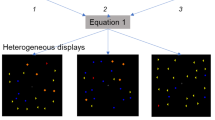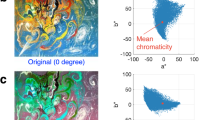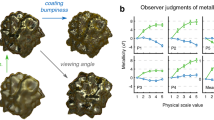Abstract
EARLY this century, E. Bullough1 showed that some combinations of colours, one above the other, are chosen as more ‘natural’ than other combinations, which tend to look top heavy. Various methods of measuring the apparent weight of colours were subsequently devised: Bullough's preference method, tests in which the weight of coloured blocks was judged either visually or directly by hand2,3,4, and the ‘weighing’ of half-inch circles of coloured paper at either end of a simulated balance arm with an adjustable fulcrum5. There was general agreement that red and blue were the heaviest colours, yellow the lightest. But no statistical evaluation was used in the earlier work; and as the colours were surface-illuminated, the effect of colour was easily confounded with that of brightness. In fact, most investigators considered that brightness was probably a crucial factor. In the present study, an adaptation of Monroe's procedures, the effects of colour and brightness were investigated separately using larger transilluminated stimuli, with brightness carefully controlled. Our results show that the effect is independent of brightness. Coloured circles, equal in subjective brightness, differ considerably in apparent weight, while achromatic stimuli which differ in brightness are not consistently different in weight.
This is a preview of subscription content, access via your institution
Access options
Subscribe to this journal
Receive 51 print issues and online access
$199.00 per year
only $3.90 per issue
Buy this article
- Purchase on Springer Link
- Instant access to full article PDF
Prices may be subject to local taxes which are calculated during checkout
Similar content being viewed by others
References
Bullough, E., Br. J. Psychol., 2, 111–152 (1907).
De Camp, J. E., J. exp. Psychol., 2, 347–370 (1917).
Taylor, C., J. gen. Psychol., 4, 229–246 (1930).
Payne, M. C., Am. J. Psychol., 71, 725–730 (1958).
Monroe, M., Am. J. Psychol., 26, 192–206 (1925).
Author information
Authors and Affiliations
Rights and permissions
About this article
Cite this article
PINKERTON, E., HUMPHREY, N. The apparent heaviness of colours. Nature 250, 164–165 (1974). https://doi.org/10.1038/250164a0
Received:
Issue Date:
DOI: https://doi.org/10.1038/250164a0
Comments
By submitting a comment you agree to abide by our Terms and Community Guidelines. If you find something abusive or that does not comply with our terms or guidelines please flag it as inappropriate.



